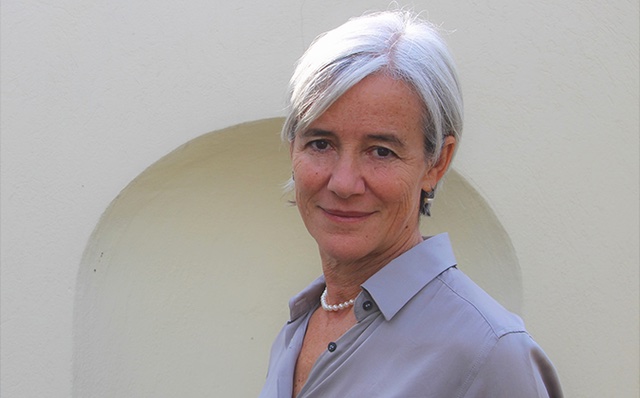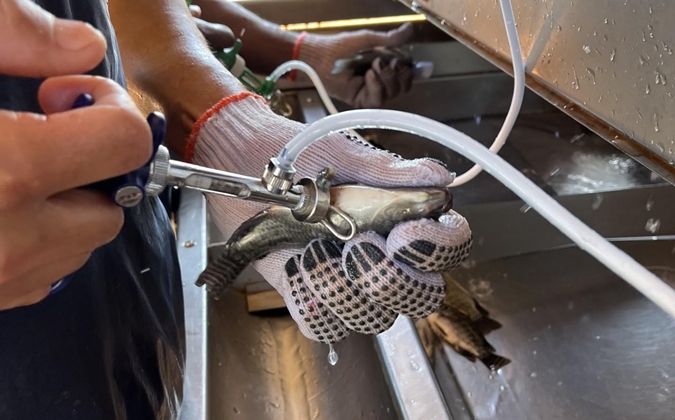
Biosecurity’s crucial role in ensuring sustainable future for global aquaculture
Photo credit: Jeanne Pruvot Simonneaux
Following their appearance at Economist Impact Ocean Summit 2022, Fish Health Forum interviewed Vera Agostini, deputy director, Fisheries and Aquaculture Division, the Food and Agriculture Organization (FAO) of the United Nations.
Q: Aquaculture is now the fastest growing food sector in the world. How much further attention to fish health and welfare do you think is necessary as global production is scaled up?
VA: Health and welfare are intrinsically linked to biosecurity management because effective animal welfare enhances the ability to resist disease. We need to promote best and appropriate handling practices, ensure the quality of water and suitable environments, while promoting good breeding practices, feed and husbandry management. All of these contribute to animal welfare.
More research and practical tools are also needed. For example, welfare indicators, currently available for salmon, should be used to assess the welfare of farmed aquatic species such as carp, tilapia and shrimp which account for the majority of our global aquatic food supply.
Q: Where do you see the biggest advances in disease management in aquaculture coming from?
VA: First, there is health management and biosecurity governance. National strategic planning for aquatic-animal health and biosecurity is vital. Without it, countries will only react in a piecemeal fashion to new developments in international trade and serious transboundary aquatic-animal diseases, and their aquaculture and fisheries sectors will remain vulnerable. FAO encourages member countries to develop and formalize national strategies on aquatic-animal health and health management procedures.
Use of clean seed is crucial. Specific pathogen free (SPF) is developed through careful management and breeding of a stock to avoid certain pathogens. Mandatory development and optimization of SPF stocks is now becoming essential for aquaculture.
Q: And what about the role of vaccines and diagnostics?
VA: Vaccines are critical for the prevention and control of fish diseases. Vaccination has been the single most important measure to control bacterial diseases in the salmon industry. While the number of commercially available fish vaccines has grown, vaccines are still unavailable for shrimp diseases as well as low-value species.
There have been great advances in disease diagnosis technologies and cutting-edge molecular methods, which have shifted the focus from traditional approaches such as clinical pathology, microscopy and histopathology. New diagnostic technologies include polymerase chain reaction methods while next-generation sequencing and artificial intelligence are not far away. But ultimately, we need to identify and promote the use of pond-side diagnostic tools that are easy to use, accurate and readily accessible to farmers.
Q: What would you say are the biggest barriers to making progress against existing and emerging pathogens? How can they be overcome?
VA: Aquaculture production is highly diverse and conducted under a wide range of social, economic and environmental conditions. The biggest challenges include regulating the trade and movement of live animals and products as well as larvae and fry, as invasive animals and pathogens can be transferred at the same time.
Promoting knowledge of pathogens and their hosts is essential, as collective awareness about the threats to many species lags behind aquaculture development, while ensuring aquatic-animal health management and creating awareness about environmental change through human activity and indirect impacts such as climate change and pollution are also very important.
We need a paradigm shift in dealing with aquaculture biosecurity risks to prevent and manage diseases of aquatic organisms or species. FAO has been developing a new initiative, called the Progressive Management Pathway for Improving Aquaculture Biosecurity (PMP/AB) with its partners since 2018 to improve awareness and advance aquaculture biosecurity.
Q: Outside of salmon farming, much of the industry remains small-scale. How can the myriad of small fish farmers be helped to play a necessary role in ensuring pathogens and parasites are managed effectively?
VA: Small-scale fish farmers dominate the sector and many have limited resources, so they represent the greatest risk in the value chain if their capacity and interests are not addressed. They need pond-side or point-of-care diagnostics as well as access to diagnostics services and capacity building on farm-level biosecurity.
Farmer organizations such as cooperatives, household farming and community-based organizations can help to enhance and promote assistance from governance authorities, industry and other concerned aquaculture stakeholders. Any intervention should pay special attention to the needs and empowerment of small-scale producers, as a matter of priority, as they often lack the means to undertake the measures needed in any biosecurity system.
Q: As you’ve noted, ecosystem changes due to environmental factors such as climate change can have significant impact on aquaculture. How do you expect the industry to mitigate the health and welfare impacts of these shifts?
VA: Aquatic ecosystems are highly vulnerable to changes in environmental factors such as temperature, rainfall, ocean acidification, the incidence of hypoxia and sea level rise. These have the potential to provoke long-term impacts on the aquaculture sector at scales ranging from the organism to the farming ecosystem, at national and global levels.
We need to work together in the development of adaptation and mitigation measures to respond to ecosystem changes. These may include raising awareness and perceptions of aquaculture stakeholders regarding the impact of climate change on aquaculture; conducting new risk assessments for biosecurity; greater monitoring of environmental factors to better predict biosecurity issues such as the incidence of toxins, pathogens and contaminants; and implementing effective early warning systems.
Q: Can you tell me about the steps FAO is taking to assist in improving biosecurity in aquaculture?
VA: To meet the ever-growing demand for fish and seafood for human consumption, aquaculture systems must become more efficient by increasing production and profitability while adopting long-term biosecurity management strategies that can greatly reduce the economic losses and environmental-related impacts caused by diseases.
Effective biosecurity requires significant resources and political commitment backed by international action and cooperation. Since 2018, FAO and its partners from other UN organizations, industry and academia, and member states have been developing PMP/AB.
It is aimed at enhancing aquaculture biosecurity by building on existing frameworks, capacity and appropriate tools through public-private partnerships. It is expected to improve farm health, minimize the global spread of disease, attract investment opportunities and optimize the economic and social benefits from aquaculture.
Posted on: April 14, 2022






